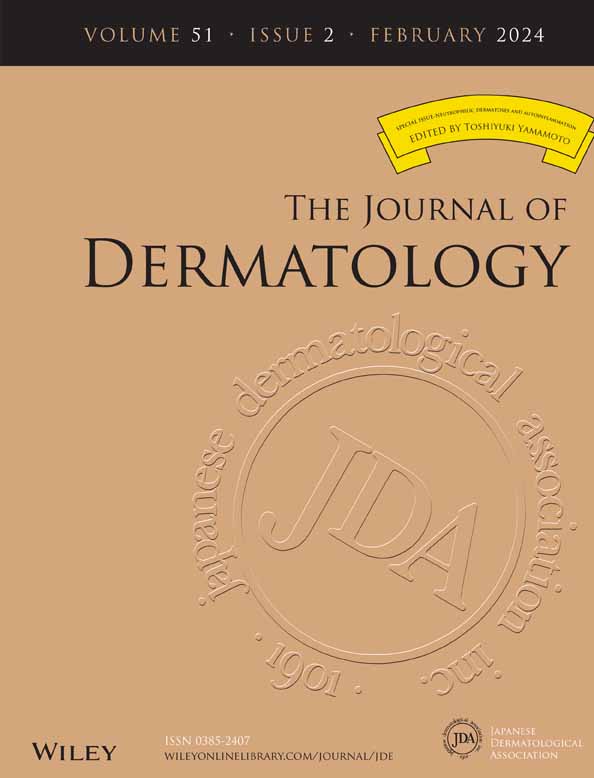Lenvatinib-induced pyoderma gangrenosum in a patient with hepatocellular carcinoma: A case report
Corresponding Author
Mirei Kanzaki
Department of Dermatology, Tokyo Medical University Ibaraki Medical Center, Ami, Japan
Correspondence
Mirei Kanzaki, Department of Dermatology, Tokyo Medical University Ibaraki Medical Center, 3-20-1 Chuou, Ami, Inashiki, Ibaraki 300-0395, Japan.
Email: [email protected]
Search for more papers by this authorAkira Honda
Joint Research Center, Tokyo Medical University Ibaraki Medical Center, Ami, Japan
Division of Gastroenterology and Hepatology, Tokyo Medical University Ibaraki Medical Center, Ami, Japan
Search for more papers by this authorYasumasa Sawai
Department of Dermatology, Tokyo Medical University Ibaraki Medical Center, Ami, Japan
Search for more papers by this authorKiyoka Suda
Department of Dermatology, Tokyo Medical University Ibaraki Medical Center, Ami, Japan
Search for more papers by this authorAyumi Suda
Department of Dermatology, Tokyo Medical University Ibaraki Medical Center, Ami, Japan
Search for more papers by this authorYasuhiro Kawachi
Department of Dermatology, Tokyo Medical University Ibaraki Medical Center, Ami, Japan
Search for more papers by this authorCorresponding Author
Mirei Kanzaki
Department of Dermatology, Tokyo Medical University Ibaraki Medical Center, Ami, Japan
Correspondence
Mirei Kanzaki, Department of Dermatology, Tokyo Medical University Ibaraki Medical Center, 3-20-1 Chuou, Ami, Inashiki, Ibaraki 300-0395, Japan.
Email: [email protected]
Search for more papers by this authorAkira Honda
Joint Research Center, Tokyo Medical University Ibaraki Medical Center, Ami, Japan
Division of Gastroenterology and Hepatology, Tokyo Medical University Ibaraki Medical Center, Ami, Japan
Search for more papers by this authorYasumasa Sawai
Department of Dermatology, Tokyo Medical University Ibaraki Medical Center, Ami, Japan
Search for more papers by this authorKiyoka Suda
Department of Dermatology, Tokyo Medical University Ibaraki Medical Center, Ami, Japan
Search for more papers by this authorAyumi Suda
Department of Dermatology, Tokyo Medical University Ibaraki Medical Center, Ami, Japan
Search for more papers by this authorYasuhiro Kawachi
Department of Dermatology, Tokyo Medical University Ibaraki Medical Center, Ami, Japan
Search for more papers by this author
REFERENCES
- 1Wu BC, Patel ED, Ortega-Loayza AG. Drug-induced pyoderma gangrenosum: a model to understand the pathogenesis of pyoderma gangrenosum. Br J Dermatol. 2017; 177: 72–83.
- 2Khoshnam-Rad N, Gheymati A, Jahangard-Rafsanjani Z. Tyrosine kinase inhibitors-associated pyoderma gangrenosum, a systematic review of published case reports. Anticancer Drugs. 2022; 33: e1–e8.
- 3Dohmen K. Severe ulcerative skin lesions due to Lenvatinib. Clin Gastroenterol Hepatol. 2020; 18:e113.
- 4Iwasa T, Adachi S, Ogiso H, Takada E, Mabuchi M, Suzuki Y, et al. Severe skin ulcer caused by taking lenvatinib after proton beam therapy. Clinical Journal of Gastroenterology. 2023. https://doi.org/10.1007/s12328-023-01802-0 Epub ahead of print.
- 5Miyagawa A, Adachi T, Takamiyagi S, Arakawa H, Matsushita M, Inazumi T. First case of lenvatinib-induced pyoderma gangrenosum: possible management with dose reduction. J Dermatol. 2021; 48: e221–e222.




